
The United States and China have agreed to establish military-to-military communication channels to prevent conflicts and ease tensions, following a “historic” meeting between U.S. President Donald Trump and Chinese President Xi Jinping in Busan, South Korea.
U.S. Defense Secretary Pete Hegseth said Saturday that he reached an agreement with Chinese Defense Minister Dong Jun to create new communication lines aimed at “deconflicting and de-escalating any problems that arise.”
The announcement came after a phone call between the two officials on Friday and their meeting on the sidelines of the Association of Southeast Asian Nations (ASEAN) Defense Ministers’ summit in Kuala Lumpur, Malaysia.
“Admiral Dong and I also agreed that we should set up military-to-military channels to deconflict and de-escalate any problems that arise. We have more meetings on that coming soon,” Hegseth wrote on X.
He added that both sides agreed “peace, stability, and good relations are the best path for our two great and strong countries.”
There was no immediate comment from Beijing.

The agreement marks a step toward restoring defense ties that have remained fragile for years.
Military communication between Washington and Beijing had largely broken down after China suspended contact in 2022, when then-U.S. House Speaker Nancy Pelosi visited Taiwan, the self-governed island Beijing claims as its own.
The suspension followed earlier years of fluctuating engagement amid repeated maritime encounters between U.S. and Chinese forces in the South China Sea and Taiwan Strait.
U.S. officials have long warned that the absence of crisis hotlines increases the risk of accidental escalation, as both militaries operate in proximity across the Asia-Pacific.
Experts say regular military contact is essential to managing competition between the two powers, whose navies frequently cross paths in contested waters.
The new defense understanding followed the Trump-Xi summit in Busan, where the two leaders agreed to take several steps to reduce tensions.
Trump announced that the U.S. would ease tariffs on Chinese goods from 57% to 47%, while China pledged to maintain the supply of rare earth metals critical to American industries.
Trump also said he would visit China in April, with Xi expected to travel to the U.S. soon after.
Hegseth said the “G2 meeting,” between Trump and Xi, set the tone for everlasting peace and success for the U.S. and China.”

While in Kuala Lumpur, Hegseth also met defense ministers from Australia, Japan, and the Philippines to discuss “increased deterrence and readiness” in the South China Sea.
“We share an ongoing commitment to ensure peace and stability in the region and are resolute in our partnership to maintain peace through strength,” he said.
He urged Southeast Asian nations to strengthen their maritime capabilities, warning against China’s “destabilizing actions” in the South China Sea.
He criticized Beijing’s declaration of the Scarborough Shoal, seized from the Philippines in 2012, as a “nature reserve,” calling it “another attempt to coerce new and expanded territorial claims.”
The U.S. defense secretary also encouraged ASEAN to finalize the long-delayed Code of Conduct with China to regulate behavior in disputed waters and proposed developing a shared maritime surveillance and rapid-response network to deter provocations.

The Chinese Ministry of National Defense said Minister Dong reiterated that the reunification of China and Taiwan was an “unstoppable historical trend” and urged Washington to act cautiously on the Taiwan issue.
Dong said China remained committed to peaceful development while “resolutely safeguarding its national security interests.”
“It possesses the full capability to respond calmly to any infringements or provocations,” the ministry said in a statement.